Related Research Articles

Dessert is a course that concludes a meal. The course consists of sweet foods, such as cake, biscuit, ice cream and possibly a beverage such as dessert wine and liqueur. Some cultures sweeten foods that are more commonly savory to create desserts. In some parts of the world there is no tradition of a dessert course to conclude a meal.
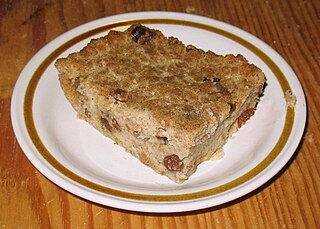
Bread pudding is a bread-based dessert popular in many countries' cuisines. It is made with stale bread and milk or cream, generally containing eggs, a form of fat such as oil, butter or suet and, depending on whether the pudding is sweet or savory, a variety of other ingredients. Sweet bread puddings may use sugar, syrup, honey, dried fruit, nuts, as well as spices such as cinnamon, nutmeg, mace, or vanilla. The bread is soaked in the liquids, mixed with the other ingredients, and baked.
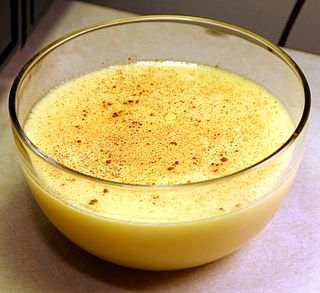
Custard is a variety of culinary preparations based on sweetened milk, cheese, or cream cooked with egg or egg yolk to thicken it, and sometimes also flour, corn starch, or gelatin. Depending on the recipe, custard may vary in consistency from a thin pouring sauce to the thick pastry cream used to fill éclairs. The most common custards are used in custard desserts or dessert sauces and typically include sugar and vanilla; however, savory custards are also found, e.g., in quiche.

Trifle is a layered dessert of English origin. The usual ingredients are a thin layer of sponge fingers or sponge cake soaked in sherry or another fortified wine, a fruit element, custard and whipped cream layered in that order in a glass dish. The contents of a trifle are highly variable and many varieties exist, some forgoing fruit entirely and instead using other ingredients, such as chocolate, coffee or vanilla. The fruit and sponge layers may be suspended in fruit-flavoured jelly, and these ingredients are usually arranged to produce three or four layers. The assembled dessert can be topped with whipped cream or, more traditionally, syllabub.
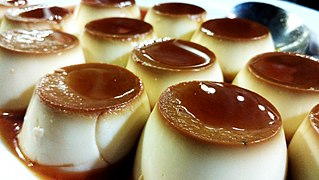
Crème caramel, flan, caramel pudding, condensed milk pudding or caramel custard is a custard dessert with a layer of clear caramel sauce.

Rice pudding is a dish made from rice mixed with water or milk and other ingredients such as cinnamon, vanilla, and raisins.

Panna cotta is an Italian dessert of sweetened cream thickened with gelatin and molded. The cream may be aromatized with coffee, vanilla, or other flavorings.

Alchermes is a type of Italian liqueur prepared by infusing neutral spirits with sugar, cinnamon, cloves, nutmeg, and vanilla, and other herbs and flavoring agents. Its most striking characteristic is its scarlet color, obtained by the addition of Kermes, a small scale insect from which the drink derives its name. Several proprietary variants are commercially available, where the coloring agent is a coal tar-derived dye such as E124 or E126, with alcoholic contents ranging from 21 to 32%. Its chief use is in coloring pastry, although a quick dessert is sometimes made by adding it to custard cream and sugar. In the Italian pudding zuppa inglese, sponge cake or ladyfingers soaked in this liqueur are a major ingredient.

A génoise, also known as Genoese cake or Genovese cake, is a French sponge cake named after the city of Genoa and associated with French cuisine. It was created by François Massialot in the late 17th century. Instead of using chemical leavening, air is suspended in the batter during mixing to provide volume.
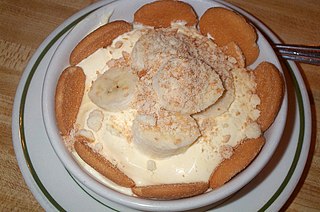
Banana pudding is a pudding generally consisting of layers of sweet vanilla flavored custard, vanilla wafers and/or ladyfingers and sliced fresh bananas placed in a dish and served, topped with whipped cream or meringue.
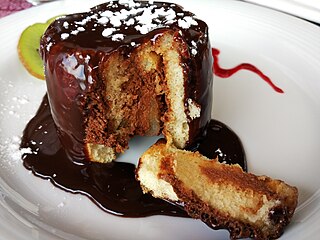
A charlotte is a type of bread pudding that can be served hot or cold. It is also referred to as an "icebox cake". Bread, sponge cake, crumbs or biscuits/cookies are used to line a mold, which is then filled with a fruit puree or custard. The baked pudding could then be sprinkled with powdered sugar and glazed with a salamander, a red-hot iron plate attached to a long handle, though modern recipes would likely use more practical tools to achieve a similar effect.

Zuppa inglese is an Italian dessert layering custard and sponge cake, perhaps derived from trifle.
Cottage pudding is a traditional American dessert consisting of a plain, dense cake served with a sweet glaze or custard. The glaze is generally cornstarch based and flavored with sugar, vanilla, chocolate, butterscotch, or one of a variety of fruit flavors such as lemon or strawberry.

Sponge cake is a light cake made with eggs, flour and sugar, sometimes leavened with baking powder. Some sponge cakes do not contain egg yolks, like angel food cake, but most of them do. Sponge cakes, leavened with beaten eggs, originated during the Renaissance, possibly in Spain. The sponge cake is thought to be one of the first non-yeasted cakes, and the earliest attested sponge cake recipe in English is found in a book by the English poet Gervase Markham, The English Huswife, Containing the Inward and Outward Virtues Which Ought to Be in a Complete Woman (1615). Still, the cake was much more like a cracker: thin and crispy. Sponge cakes became the cake recognised today when bakers started using beaten eggs as a rising agent in the mid-18th century. The Victorian creation of baking powder by English food manufacturer Alfred Bird in 1843 allowed the addition of butter to the traditional sponge recipe, resulting in the creation of the Victoria sponge. Cakes are available in many flavours and have many recipes as well. Sponge cakes have become snack cakes via the Twinkie.

A tipsy cake is a sweet dessert cake, made originally of "fresh sponge cakes soaked in good sherry and good brandy". The dish as prepared in England would typically have several small cakes stacked together, with the cracks between bristling with almonds. As a variety of the English trifle, tipsy cake is popular in the American South, often served after dinner as a dessert or at Church socials and neighbourhood gatherings. It was a well known dessert by the mid 19th century and was included Mrs Beeton's Book of Household Management in 1861.
References
- ↑ Montagné, Prosper; Harvey Lang, Jenifer (1998). Larousse Gastronomique (New American ed.). New York: Crown Publishers, Inc. p. 375. ISBN 0-517-57032-7.